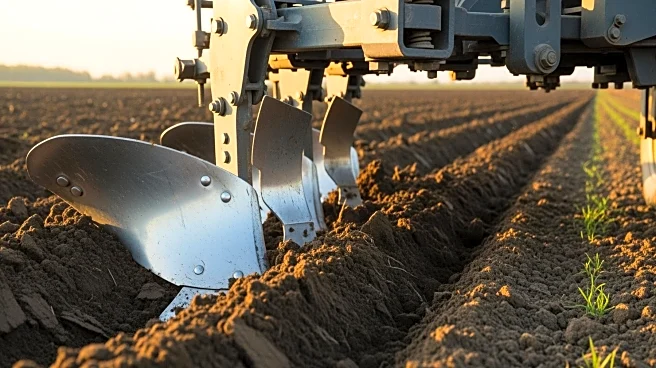What's Happening?
Fall tillage is a critical agricultural practice aimed at preparing fields for the next planting season. By incorporating organic matter and fertilizer, farmers can ensure nutrients remain available for crops in the spring. Vertical tillage tools are
used to chop up residue and lightly work the top layers of soil, preventing runoff and maintaining soil health. Experts recommend breaking up compaction layers and smoothing out ruts left after harvest to optimize soil conditions. Proper inspection and maintenance of tillage equipment are essential to avoid delays and ensure efficient operation. Technological advancements, such as automated settings and adjustments, further enhance tillage efficiency.
Why It's Important?
Effective fall tillage practices are vital for maximizing crop yield and ensuring soil health. By managing residue and breaking up compaction layers, farmers can improve soil drainage and root penetration, leading to healthier crops. The use of technology in tillage operations reduces labor costs and increases precision, allowing farmers to adapt to varying soil conditions. These practices contribute to sustainable agriculture by minimizing soil erosion and nutrient loss, aligning with broader environmental goals. As consumer demand for fresh and organic produce grows, efficient tillage becomes increasingly important for meeting market needs.
What's Next?
Farmers are likely to continue adopting advanced tillage technologies to improve efficiency and reduce environmental impact. Companies may focus on developing more sophisticated tools that offer greater automation and precision. As technology evolves, there may be increased collaboration between equipment manufacturers and agricultural research institutions to refine tillage practices. The integration of data analytics and machine learning could further enhance decision-making in tillage operations, leading to more sustainable and productive farming methods.
Beyond the Headlines
The emphasis on fall tillage highlights the importance of soil management in sustainable agriculture. As farmers adopt more advanced techniques, there may be shifts in agricultural education and training programs to equip workers with the necessary skills. The focus on soil health and nutrient management aligns with global efforts to combat climate change and promote environmental sustainability. Additionally, the adoption of technology in agriculture could lead to increased investment in rural areas, fostering economic development and innovation.















